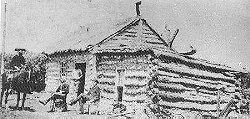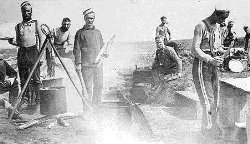



General Middleton recorded his experiences and observations of the uprising in his book - "Suppression of the Rebellion in the North West Territories of Canada". On his arrival at Humboldt he wrote:
"Next day, the 13th of April, we halted at Humboldt after doing 21 miles. The trail bifurcates here, one going direct to Batoche or Prince Albert, the other to Clarke's Crossing. There was a telegraph station and two or three houses. Hitherto, I had only one piquet mounted at night, but now I thought it advisable to mount two. Major General Laurie left us the day for Swift Current. We had now marched 124 miles from Fort Qu'Appelle in eight days including a day's halt over a bad trail, in worse weather, which was good work for untrained men. We had a little sickness, plenty of supplies, tea, tobacco, canned meat, bacon, and capital biscuits, called by the men "hard track", and the whole force was in good heart. We halted the next day, the 14th, and took out French's Scouts foe a reconnaissance towards Batoche but saw nobody. Captain Haig, Royal Engineers, joined the camp that day. I made him Assistant Quarter-Master General. After a cold, wet and blowy night, we started for Clarke's Crossing next day, April 15th, at 7 a.m. and halted after a 23-mile march."
R.C. Laurie had additional observations on that part of the journey in his book:
"Our next stop was Humboldt on our sixth day form Qu'Appelle. We were now on fine dry prairie, the trail running among scattered poplar bluffs, and we were making good time. We went into camp at noon and had another half day's rest."
Events were taking place rapidly as the mounted police and army personnel moved to deal with the rebel forces. Col. Irvine, now positioned at Prince Albert, established a courier service south-east beyond the Birch Hills and across the Carrot River to Humboldt in order to keep some contact with the outside world.
Excerpts taken from: Humboldt On The Carlton Trail,1975.
There is a Humboldt Journal article pertaining to this subject:
 Man Is Found Who Carved Name On Stone Near Humboldt In 1885
Man Is Found Who Carved Name On Stone Near Humboldt In 1885
![]()
[ Home ]
[ The Humboldt Journal
[Early Humboldt]
[ St. Peter's Abbey | Agriculture | Communities ]
[ Present-day Humboldt and Surrounding Communities ]
[ Language ]
![]()
Please send comments to Carlton Trail REDA Inc.